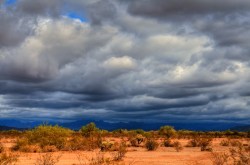
Shutterstock / Paul B. MooreThese dark clouds will be coming later and later.
As if the parched Southwestern U.S. didn’t have enough problems already, here’s another one.
The quenching storms that take the edge off the scorching heat near parts of the U.S.-Mexico border during the hottest months are arriving later than they used to. New research indicates that climate change could push their arrival back nearly until the fall by the end of the century.
That’s because it’s becoming more difficult for rain-forming clouds to materialize until the atmosphere becomes saturated later in the summer season, when the skies finally explode in rainstorms over parts of Arizona, New Mexico, Texas, and northwestern Mexico.
The fallout from a substantially delayed monsoon season, which is predicted in a new study published in the Journal of Geophysical Research, could include crop failures and increasingly uncomfortable summers.
It’s not that the North American monsoon is going to deliver less rain — which is good, because it provides 70 percent of the region’s annual rainfall, recharging rivers, aquifers, and reservoirs and bringing new life to desert ecosystems. The problem is that the rains will arrive progressively later, causing havoc for the ecosystems, farmers, and water supply systems that have come to rely on them.
From a press release put out by Columbia University’s Lamont-Doherty Earth Observatory, where both authors of the study are based:
Much of the arid U.S. Southwest is expected to get even drier as winter precipitation declines under climate change, but the present modeling study predicts that summer rain levels will stay constant over southern Arizona and New Mexico, and northwestern Mexico. What will shift is the arrival of the heaviest rains, from July and August or so, to September and October, the study says. “There still will be a healthy monsoon which is good news for agriculture in the southern U.S. and northwestern Mexico — the timing is the problem here,” said study co-author Richard Seager, a climate scientist at Lamont-Doherty.
A delayed monsoon could potentially lower crop yields as rains come later in the growing season, when the days are getting shorter. By prolonging hot and dry conditions during spring, a late monsoon could also trigger more wildfires and force cities to stretch diminished water supplies.
Previous research had already concluded that the monsoons are arriving later. This graph from the new paper shows the recorded and predicted drops in June and July regional rainfall between 1980 and 2100, along with increases in rainfall during later months.




